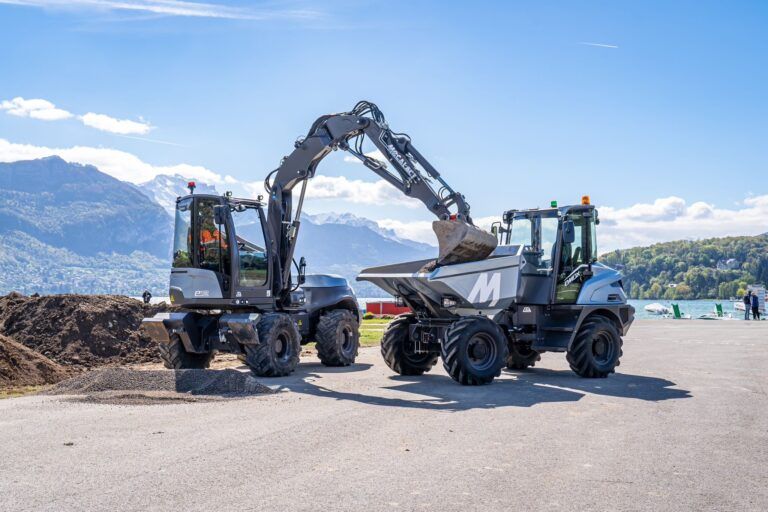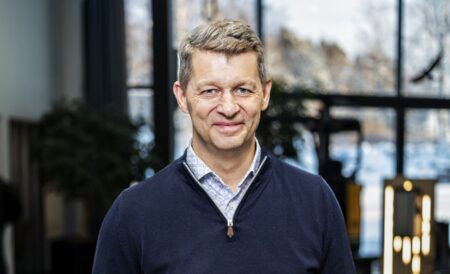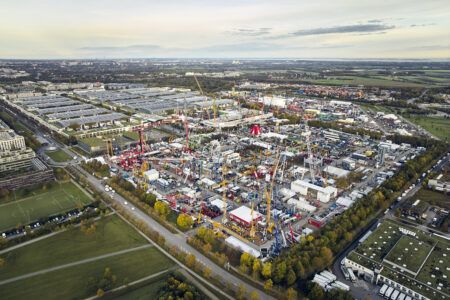Mecalac’s eS1000 electric swing loader, in unison with its other medium-sized EVs, is already revolutionising urban jobsites, enabling end-to-end operations with zero emissions, not to mention radically reduced noise and vibration.
In 2018, iVT chronicled a nascent French revolution built upon efficacité (efficiency), compacité(compactness) and autonomie (autonomy). Groupe Mecalac, French creator of process-oriented machines often for confined urban sites, stood poised to launch its e12 electric excavator built on its versatile 12MTX template.
Five years on at Bauma 2022, the company demonstrated the now battle-hardened e12 working in concert with the electric eS1000 swing-loader and eMDX dumper – a threefold gendarmerie reckoned to save an average 64 tonnes of C02 emissions each year across one site.
“There are dozens of electric mini-excavators,” says Mecalac head of design and product management, Patrick Brehmer. “But urban jobsites require compact machines with strong lifting and deep excavating capabilities. We wanted to electrify the heart of the market. For Mecalac, the first wave of electrification consists of medium-sized machines: an 11-tonne wheeled excavator, 1000-litre swing-loader and six-tonne capacity dumper.”
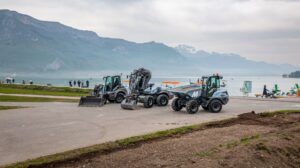
Day-long autonomy
Mecalac characterises all three machines as comfortably delivering eight-hour autonomy irrespective of conditions. The e12’s efficacité was achieved through the versatile, articulated architecture of its 12MTX diesel counterpart, which separates the engine (or batteries) from a compact, rotating turret. Likewise, the eS1000 achieves day-long autonomy through economies of motion inherent in its diesel template: the AS1000 swing-loader.
“We chose to electrify the most process-innovative machines,” says Brehmer. “Classical loaders spend 80% of their time driving, but a swing-loader can unload at 90° by rotating its boom. It therefore works for 80% of the time, completing the same job three times faster – for example, filling a trench with sand to lay a pipe.”
Conventional loaders would need to manoeuvre between pile and trench to deliver each bucketload of sand. By contrast, the eS1000 can sit parallel to the trench and lay sand more neatly, simply swinging its boom back and forth to the pile. This not only saves time but avoids depleting batteries in repetitious driving cycles which adds no value for customers.
Ideal for electrification
Loaders typically drive for 30 seconds to move each bucketload. A swing-loader drives less, making it safer, requires less space and doesn’t furrow the ground. The AS1000 is Mecalac’s most-used machine. Because driving consumes a lot of power, it does more work with the same energy, making it apt for electrification.
At 1990mm wide with a 7,085kg total operating weight, the eS1000 provides 2650mm lift height with 4300kg tipping load. It comes with 1m3 bucket as standard, with variants available up to 1.5m3. Lithium nickel manganese cobalt (NMC) batteries with nominal 75kWh capacity deliver power to separate electric motors for driving, lifting and swinging.
“Where our classic machine has three pumps, the eS1000 has three motors. It means lift and swing functions are independent of driving speed, so you don’t have to burn gas and inch the pedal to work quickly while moving slowly. The operator need only think what they want to do, move the joystick and the electric motors respond at three different speeds for perfect control.”
Carrying 6m lengths of pipe or rail at 90 degrees to a conventional loader’s fixed boom becomes problematic in confined spaces, effectively increasing vehicle width to 6m. By rotating its boom 90 degrees, the eS1000 can transport such loads parallel to its own length, as a person would carry it under their arm. It can lift and turn a loaded bucket through 180° without any loss of stability.
“We want to swing, but we also want stability,” says Brehmer. “If you articulate, you move your
centre-of-gravity and create a risk of tipping. The secret of stability is a rigid chassis with four-wheel steering. The turning component has an independent counterweight and the rear-axle locks automatically as soon as you enter a swing. It means whatever you lift at the front, you can put down at the side.”
“We watch every machine on telematics. They really do work for eight hours”
Improved power-density
When iVT spoke to Brehmer in 2018, Mecalac was readying to launch the e12 excavator with lithium iron phosphate (LFP) battery technology. Since then, it has switched to lithium nickel manganese phosphate (NMC) batteries across its electric triumvirate. Crucially, NMC offers improved power-density, or KWh per cm3 of batteries.
“NMC batteries are now really safe, which maybe wasn’t always the case. We found an excellent partner in Swedish company, Northvolt. Northvolt measures the kilograms of CO2 emitted per kWh of manufactured battery, while its extraction process is responsible and human-oriented. Our batteries will be recycled after the machine’s lifetime, because Northvolt is the world’s first manufacturer to recycle old batteries into new ones.”
Mecalac’s vision goes beyond simply eliminating on-site tailpipe emissions to consider the cradle-to-grave vehicle footprint of based on analyse du cycle de vie. Its electric machines are made exclusively from steel transformed by Hydromo, a wholly-owned Mecalac subsidiary.
The e12 is assembled in Annecy, France. All undercarriage structures, turrets, booms and cylinders are manufactured by Hydromo from French raw materials and come only 30 miles by road. Mecalac closely surveys CO2 and particulate production across the whole lifecycle. According to Brehmer, you cannot make a machine with a lower footprint than the e12.
Minimising power demand
Electrification means optimising power density within compact architectures which balance efficacité and compacité. The other side of the equation involves minimising power demand across the machine to ensure eight-hour autonomie can be achieved with the available capacity.
Here, avoidance of power-intensive manoeuvres serves the eS1000 well, while optimised electrohydraulics on the e12 further reduce power consumption. Meanwhile, fluid-based heating and cooling keeps individual cells always at ideal operating temperatures.
“Batteries can lose up to 50% of performance in the cold and cannot be charged below
0°C. In winter, other machines don’t deliver the eight hours promised and dealers say, ‘Ah, but that’s the September autonomy’. We say, ‘No. Our machine works for eight hours in winter, in summer,
with maximum heating or air-conditioning’. We have two heating and cooling systems with radiators and fans – one for the cells, one for electric motors and components.”
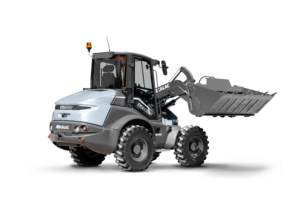
Matching diesel equivalent
Brehmer reports that the eS1000 comfortably matches the performance delivered by its AS1000 diesel stablemate, but with the instantaneous torque provided by electric motors making it an altogether more dynamic ride than the diesel. Its vital statistics differ in only two respects. The additional counterweight its batteries provide underwrites a marginally-increased tipping load and, whereas the AS1000 comes in 20km/h (12.5mph) and 40km/h (35mph) variants, the eS1000 is limited to 25km/h.
“We limited the speed because high speed really drains batteries. In Germany, the world’s largest wheel loader market, nobody drives over 20km/h anyway, because it would incur additional taxes. 25km/h is sufficient in cities, where average traffic speeds are below 25km/h. For longer distances, it’s easily transported by truck.”
Exceeding battery expectations
Mecalac began shipping e12 electric excavators to customers in November 2022. A versatile machine which both digs and loads, the e12 can be utilised almost continuously. Mecalac reports battery performance from machines in the field which dramatically exceeds the eight-hour autonomy promised by Mecalac and targeted by electric vehicles from most OEMs.
“We watch every machine on telematics. They really do work for eight hours. In France, the Netherlands, Norway, Sweden, Switzerland, in hot or cold weather, the promise of autonomy was kept – and always between 30% and 50% charge remaining at the end of the day.”
Brehmer attributes this eye-catching claim to warranty terms which guarantee autonomy over time, with a replacement provided if machines fail to deliver a full day’s work within the first five years. Since deterioration in battery performance of up to 5% can be expected each year, new machines are built to exceed the eight-hour threshold by at least 25%. Similar terms will apply to the eS1000 and eMDX site dumper, both launched to market in January 2024.
“The eMDX six-tonne dumper uses the same battery technology as the e12 excavator and eS1000 swing-loader. Like the eS1000, it achieves eight-hour autonomy with 75kWh net installed capacity, compared to 150kWh for the e12. One motor is dedicated to driving and regenerative braking means the machine uses zero battery coming downhill.”
Affordable machine lease
Mecalac applies the spirit of innovation manifest in its machines to all aspects of its business. Whilst technical invention underwritten by warranty resolves customer reservations about autonomy and longevity, the Mecalac Financial Solution addresses fears about the cost of electric vehicle ownership. Based on high residual values, it allows customers to affordably lease
a machine for five years, then either buy it or return the key.
The company opted out of Intermat Paris this year as it rethinks customer connections in a post-pandemic world. “We would like to innovate a new way to approach our customers. At fairs, you have three minutes to talk before they continue to the next booth. We’re working on an internal event later in 2024.”
The eS1000 takes its place in Mecalac’s three-machine lineup enabling end-to-end jobsite operations with zero emissions, not to mention radically reduced noise and vibration. These medium-sized vehicles represent the first wave of electrification: compact prizefighters bringing real muscle to the urban heart of Mecalac’s market. Brehmer is tight-lipped about the next electrification project, except to say these vehicles will be the first of many. What seems certain is that for Mecalac, revolution is perpetual.
This article also appears in the June/July 2024 edition of iVT International


